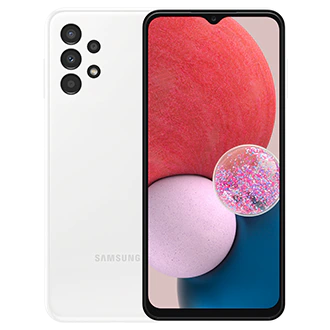Introduction
Samsung has been a dominant player in the smartphone market for years, offering a wide range of devices catering to different budgets. The Samsung Galaxy A13 is one of the latest additions to the company’s budget-friendly A-series lineup. Designed to deliver essential features at an affordable price, the Galaxy A13 aims to provide a balanced experience for users who need reliability without breaking the bank.
In this in-depth review, we’ll explore the design, display, performance, camera, battery life, software, and overall value of the Samsung Galaxy A13. By the end, you’ll have a clear understanding of whether this smartphone is the right choice for you.

Design & Build Quality
The Samsung Galaxy A13 follows a minimalist yet modern design approach, similar to other A-series phones. It features a plastic back and frame, which helps keep the device lightweight (around 195g). While it may not feel as premium as glass-backed phones, the plastic construction makes it more durable against accidental drops.
Key Design Features:
- Dimensions: 165.1 x 76.4 x 8.8 mm
- Weight: 195g
- Colors: Black, White, Blue, and Peach
- Rear Camera Setup: Quad-camera module with a clean, rectangular design
- Fingerprint Sensor: Side-mounted (embedded in the power button)
The phone has a 3.5mm headphone jack and a USB Type-C port for charging and data transfer. The placement of buttons is ergonomic, and the overall grip is comfortable for one-handed use.
Display
The Samsung Galaxy A13 features a 6.6-inch PLS LCD with Full HD+ resolution (1080 x 2408 pixels). While it doesn’t use Samsung’s superior AMOLED technology (found in higher-end models), the display is still sharp and vibrant for everyday use.
Display Specifications:
- Type: PLS LCD (60Hz refresh rate)
- Size: 6.6 inches
- Resolution: 1080 x 2408 pixels (~400 PPI)
- Brightness: Decent for indoor use, but visibility under direct sunlight could be better
The 60Hz refresh rate is standard for budget phones, meaning scrolling and animations won’t be as smooth as on high-refresh-rate displays (90Hz or 120Hz). However, for casual users, this won’t be a major drawback.
Performance & Hardware
The Samsung Galaxy A13 is powered by the Exynos 850 chipset, an entry-level processor designed for basic tasks. It’s paired with 3GB/4GB/6GB RAM options and 32GB/64GB/128GB storage (expandable via microSD up to 1TB).
Performance Benchmarks:
- CPU: Octa-core (4×2.0 GHz Cortex-A55 & 4×2.0 GHz Cortex-A55)
- GPU: Mali-G52
- AnTuTu Score: ~110,000 (entry-level performance)
Real-World Usage:
- Daily Tasks (Social Media, Browsing, YouTube): Smooth
- Multitasking: Handles light apps well, but may struggle with heavy apps
- Gaming: Can run casual games (e.g., Candy Crush, Subway Surfers) but struggles with high-end games (e.g., Genshin Impact, Call of Duty Mobile) at high settings
If you’re looking for a phone primarily for calls, messaging, social media, and light gaming, the Galaxy A13 performs adequately. However, power users and gamers should consider a more capable device.
Camera Performance
The Samsung Galaxy A13 features a quad-camera setup, which is impressive for a budget device. However, the quality varies depending on lighting conditions.
Rear Camera Specifications:
- Main Camera: 50MP (f/1.8) – Good detail in daylight
- Ultra-Wide Camera: 5MP (f/2.2) – Useful for group shots and landscapes
- Macro Camera: 2MP (f/2.4) – Decent for close-ups
- Depth Sensor: 2MP (f/2.4) – Helps with portrait mode
Front Camera:
- 5MP (f/2.0) – Suitable for video calls and basic selfies
Camera Performance Analysis:
- Daylight Photos: Good color reproduction and sharpness
- Low-Light Photos: Noisy, lacks detail (Night mode helps slightly)
- Video Recording: Up to 1080p at 30fps (No 4K or stabilization)
While the camera setup is versatile, the image processing isn’t as refined as in mid-range or flagship Samsung phones. Still, it’s decent for social media and casual photography.
Battery Life & Charging
One of the strongest aspects of the Galaxy A13 is its 5000mAh battery, which easily lasts 1.5 to 2 days with moderate usage.
Battery Performance:
- Screen-On Time (SOT): ~7-9 hours (varies by usage)
- Standby Time: Excellent (minimal drain when idle)
- Charging: 15W fast charging (No wireless charging)
A full charge takes about 2 hours, which is slower than some competitors offering 18W or 25W charging. However, the long battery life compensates for the slower charging speed.
Software & User Experience
The Samsung Galaxy A13 runs Android 12 with One UI Core 4.1 (a lighter version of Samsung’s One UI optimized for budget devices).
Software Features:
- Clean, user-friendly interface
- Dark Mode, Digital Wellbeing, and Samsung Knox security
- Guaranteed software updates (at least 2 major Android updates and 4 years of security patches)
Samsung’s One UI is one of the most polished Android skins, offering useful customization options and smooth navigation.
Connectivity & Additional Features
Connectivity Options:
- 4G LTE (No 5G support)
- Wi-Fi 5, Bluetooth 5.0, GPS
- NFC (region-dependent) – Useful for contactless payments
Other Features:
- Dual SIM support
- MicroSD card slot (up to 1TB)
- 3.5mm headphone jack
The lack of 5G might be a downside for future-proofing, but for most users, 4G is still sufficient.
Pros & Cons
Pros:
✅ Large, vibrant display (Full HD+)
✅ Excellent battery life (5000mAh)
✅ Decent quad-camera setup
✅ Reliable One UI software with long-term updates
✅ Affordable price
Cons:
❌ Weak processor (Exynos 850 struggles with heavy tasks)
❌ No high refresh rate display
❌ Average low-light camera performance
❌ Slow charging (15W)
❌ No 5G support
Samsung Galaxy A13 vs Competitors
1. Samsung Galaxy A13 vs Redmi Note 11
- Redmi Note 11 offers a better processor (Snapdragon 680) and AMOLED display but has a weaker software update policy.
- A13 has a larger battery and longer software support.
2. Samsung Galaxy A13 vs Realme 9i
- Realme 9i has a 90Hz display and faster charging (33W) but lacks Samsung’s software optimization.
3. Samsung Galaxy A13 vs Moto G32
- Moto G32 has a 90Hz display and cleaner Android experience, but the A13 has better cameras and battery life.
Final Verdict: Who Should Buy the Samsung Galaxy A13?
The Samsung Galaxy A13 is an excellent choice for:
- Budget-conscious buyers who want a reliable Samsung phone
- Casual users (social media, browsing, light gaming)
- Those who prioritize battery life
- Users who prefer Samsung’s software experience
However, if you need better performance, faster charging, or a high-refresh-rate display, consider alternatives like the Redmi Note 11 or Realme 9i.
Rating: 7.5/10
- Design: 7/10
- Display: 7.5/10
- Performance: 6.5/10
- Camera: 7/10
- Battery: 9/10
- Software: 8/10
Conclusion
The Samsung Galaxy A13 is a solid budget smartphone that delivers where it matters most: battery life, display quality, and software support. While it may not excel in performance or camera capabilities, it’s a dependable choice for everyday use. If you’re looking for an affordable Samsung device with essential features, the Galaxy A13 is worth considering.

